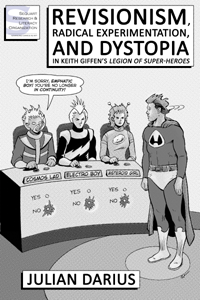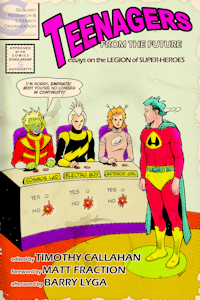We previously introduced Invasion and discussed its first and second issues. Today, we conclude our look at Invasion with issue #2.
Invasion #3 begins with this same explosion, revealed to be a “gene bomb” released as a last-ditch effort to neutralize the metagene. Its immediate effect is to cause Earth’s superhumans to lose their powers. (Animal Man, flying at the time, fell out of the sky – a perfectly logical eventuality undermined by his convenient landing in a dolphin tank.) These heroes powers then go crazy, threatening both teammates and civilians. Heroes whose powers are technological in nature (and are thus not affected) have to contain and round up the others. Meanwhile, super-villains and normal criminals take advantage of the heroes’ absence to riot and to loot in the wreckage left by the alien invasion. The affected superhumans soon fall deeply ill, lapsing into comas, and the government establishes a facility under military guard to care for them. We soon see that prominent characters such as Flash, Firestorm, and Captain Atom are among the unconscious.
One of the issue’s most memorable pages is when we first see the afflicted. After a nine-panel page on which Dr. Megala (creator of Captain Atom) explains the metagene and the effect of the gene bomb, the next page features a single panel, depicting cots sprawled out across an enormous room, each one of them holding one of DC’s superhumans. The image recalls the famous scene of the Confederate wounded in Atlanta in the 1939 film adaptation of Gone with the Wind, in which the camera slowly zooms out (and continues to do so, to the audience’s disbelief), emphasizing the sheer number of the wounded. Of course, this version lacks motion and is limited to a single full-page image, but it similarly uses the edge of the frame / panel to suggest a vast expansiveness.
With no hope of developing a cure, Maxwell Lord (of the Justice League International) assembles a team of unaffected heroes to search for an antidote on the Dominion world. The team consists of Green Lanterns Hal Jordan and Guy Garder, Martian Manhunter, Rocket Red, Starman (the one before the one seen in DC One Million), and Robotman (of the Doom Patrol). No sooner has he done this than Maxwell Lord, himself a limited superhuman, collapses.
Leaving Earth, the team joins up with the self-exiled Superman, who has been watching from orbit, unwilling to return to the planet below. The Omega Men arrive, along with several refugees from Starlag, including Snapper Carr, the Justice League’s former human mascot who had since acquired teleportational powers. Together, they go to the Dominion world.
Not long after the team’s departure from Earth, a sick hero dies: Scott Fisher, a member of the Doom Patrol and that team’s second member to die during the crossover. Unless the heroes can find a cure on the Dominion world, Scott Fisher may be the first of many. On the other hand, the dead super-hero Metamorpho seems to have been resurrected by the gene bomb.
That bomb was designed and activated by a single rogue Dominion scientist. On page eight of Invasion #1, he tries to offer an alternative to the Dominion’s plans to invade Earth, only to be shouted down because he comes from a lower caste. This same Dominator is given a four-page sequence in the middle of Invasion #2, in which he’s shown to have identified the metagene. He’s continued his research despite being rejected, and he hopes that his success will cause him to be elevated into a higher caste. The culmination of his research is the gene bomb, which he’s shown detonating in the opening pages of this issue. Although he originally sought to suggest it as a way of preventing a costly invasion, he now thinks that detonating it means that he has single-handedly won the apparently lost war.
Unbenounced to him (and to the Dominion’s allies), the Dominion planned to use Earth’s superhumans as weapons. For the Dominion, the invasion had really been about harnessing Earth’s potential, rather than eliminating it. This is exactly what the Dominator transmission alleged in issue #2, causing the alliance to fall apart. Apparently, that wasn’t Deadman’s doing after all. (Characters Deadman possesses normally have a yellow glow, and the Dominator sending that transmission doesn’t. Still, it would be easy to justify this as an artistic error, or to assume that the glow, invisible except to readers, doesn’t transmit through video.) The Dominion, now at war with its former Khund allies, tortures the gene-bomb scientist in hopes of discovering a way to reverse the bomb’s effects. Once this is ascertained, he is to be beheaded.
Using Snapper Carr’s teleportational powers and Martian Manhunter’s ability to change shape (and thus to assume the form of a high-caste Dominator), the heroes infiltrate the Dominion world. The heroes find the Dominion scientist, and Martian Manhunter reads his mind. In a rather ethically dubious move, the heroes leave him in his cell; we’re left to assume he’ll continue to be tortured and will eventually be executed.
The antidote can only be produced using the scientist’s lab on Starlag, forcing the Omega Men and the Starlag escapees to break back into the prison from which they escaped. The heroes are successful, of course, and Martian Manhunter uses the lab to synthesize the antidote.
Back at Earth, Superman takes his leave, having borrowed a portable teleportation device from the Omega Men. Instead of returning to Earth, he lies to Hal Jordan and remains in orbit, where he’d soon begin his belated exile.
(In the Superman titles, the teleportation device would play a key role. But if the Omega Men had such a device, why did Snapper Carr’s teleportation powers play such a key role in the infiltration of the Dominion world? One can guess that this is a case in which a continuing title wanted a crossover to set something up, and Giffen was forced to oblige. This theory is supported by the fact that the thought balloon in which Superman explains where he got the teleportation device – otherwise not established in any way – is clearly lettered in a different style from the rest of the issue, suggesting a late addition.)
To distribute the cure, it’s detonated over the planet, much as the gene bomb had been. The issue ends, like issue #1, with full-page headline on the front page of The Daily Planet. This one reads: “REBIRTH! EARTH’S HEROES CURED!”
While it follows threads from the first two issues, issue #3 feels more like an epilogue or a coda than a conclusion, which had effectively occurred in the second issue. Helping to separate the third issue from the previous two, it was penciled by Bart Sears, who hadn’t worked on the previous two issues.
Reading issue #3 as part of a series, it’s hard not to wonder why, symmetry aside, this coda was given the same amount of space as the previous two issues, especially the jam-packed issue #2. One can’t help but wish that issue #2, given its broad scope, had been able to borrow some pages from issue #3.
Aiding this sense, the structure of issue #3 is filled with unnecessary sequences that seem designed to give characters something to do. After all, the main story is simply that the heroes with active metagenes are sickened, and a few heroes go to the Dominion world for a cure. That might even have been accomplished in half as much space, although it wouldn’t make for a very satisfying issue of a universe-wide crossover, since its plot sidelines almost all of DC’s super-heroes.
In particular, the period during which the afflicted heroes’ powers go crazy takes up several pages and is totally unnecessary to the larger plot. This sequence’s only real function is to include the affected characters, who otherwise wouldn’t be seen at all. Their loss of control is suitably dramatic, especially as their colleagues struggle to restrain them. But this isn’t exactly an original plot development: super-hero readers have seen innumerable instances of super-powers going haywire, as well as probably every excuse to get super-heroes to battle one another (a huge cliché of the genre, though one more closely associated with Marvel than DC).
A briefer but similar case occurs as the heroes prepare to leave the Dominion world. The Dominators spot the Omega Men’s ship and attack. Superman and the two Green Lanterns thus get to rip apart some Dominion ships before the story continues. The sequence serves no purpose except to give these popular characters an action sequence.
Similarly, there’s no reason to require the heroes to visit Starlag to synthesize the antidote – except perhaps to add one more obstacle and perhaps to give the Starlag escapees something to do, since they’re featured prominently in this sequence.
Given these unnecessary detours, it’s surprising that the issue’s ending feels so abrupt. The previous issues ended well, with room after their climaxes to at least tease out a sense of what happens next. Here, we’re not even shown the heroes reviving, nor regaining control of a rioting world.
Without a doubt, issue #3 is the weakest chapter of the series – although it helps that we can think of it as an epilogue, rather than a conclusion. The chapter’s best elements almost all focus on the Dominion, rather than on the super-heroes. The story of the lone Dominion scientist, failing to understand the rigidity of his own society’s caste structure or the sheer duplicity of its leaders, is fascinating enough that it deserved more space. Throughout the series, the depiction of the Dominion is a strong suit, and scenes set on the Dominion world depict a desolately technological architecture that’s both stark and beautiful. That’s true in this issue too, where the architecture of the Dominion world is given a bit more room and constitutes one of the issue’s high points.
































































“We soon see that prominent characters such as Flash, Firestorm, and Captain America are among the unconscious.”
Is Cap another character the artist snuck in the coma ward with all the other DC characters? Hey, did you see someone who looks like Charlie Brown lying amoung the comatose? You kind of have to squint your eyes to see him.
Nice catch, Brad. I’ll fix it.
Found this interesting: Scott Fischer, the Doom Patroller who dies from the Gene Bomb’s effects, was effectively killed off per request by Grant Morrison. In fact, he used the Gene Bomb to wipe out most of Kupperberg’s team, so Morrison could start on Doom Patrol #18 with a clean slate.
I had read that, but maybe I forgot! Thanks for the reminder!